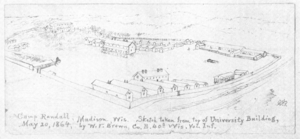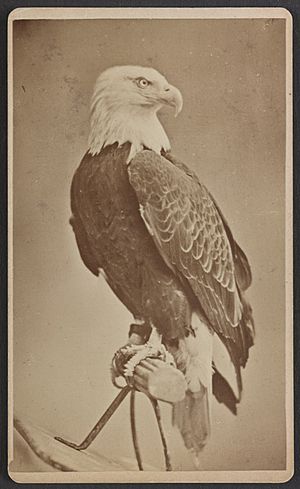Angus R. McDonald facts for kids
Captain Angus R. McDonald (born 1832 in Eigg, Scotland – died 1879 in Milwaukee, Wisconsin, USA) was a brave Scottish man who moved to the United States. He became an officer in the Union Army during the American Civil War. Many people remember him as one of Wisconsin's greatest heroes from that war.
Contents
Early Life in Scotland and America
Angus McDonald was born on the small island of Eigg in Scotland. His family had a long history, connected to famous Scottish figures like King Robert the Bruce. His great-grandfather was a well-known poet named Alasdair Mac Mhaighstir Alasdair. This poet even taught Prince Charles Edward Stuart (also known as Bonnie Prince Charlie) during a big uprising in 1745.
After his father passed away, Angus continued to work on the family farm on Eigg. When he was 24, he moved to the United States with his mother and a relative named Allan. They became some of the first people to settle in Mazomanie, Wisconsin. In Mazomanie, Angus and Allan McDonald built the town's first hotel. Later, they gave the hotel to St. Barnabas Roman Catholic Church, which turned it into a Catholic school.
Fighting in the American Civil War

When the American Civil War began, Angus R. McDonald joined the army. He enlisted in Company A of the 11th Wisconsin Regiment in Mazomanie on September 2, 1861. After his basic training at Camp Randall, McDonald served under Colonel Charles L. Harris. He was known for being very brave during battles in Alabama and Mississippi. People described him as a "very large and powerful man" who was incredibly courageous. He was promoted to 1st Lieutenant on July 14, 1864.
The Hero of Fort Blakeley
One of Angus McDonald's most famous moments was during the Battle of Fort Blakeley. This battle was part of the Siege of Mobile and happened on April 9, 1865. Lieutenant McDonald was bravely leading a group of soldiers to attack a Confederate fort. Suddenly, a Confederate officer and twelve soldiers launched a surprise attack. They were shouting and shooting, hitting both Union soldiers and even some surrendered Confederate soldiers.
Lieutenant McDonald was shot in the leg. Then, a Confederate soldier repeatedly attacked him with a bayonet. Luckily, Sgt. Daniel B. Moore of Company E saw what was happening. He quickly grabbed a fallen enemy's musket and shot McDonald's attacker, saving his life. For this brave act, Sgt. Moore later received the Congressional Medal of Honor.
After about 15 minutes of intense fighting, the flag of the 11th Wisconsin Regiment was placed on top of the captured fort. Lieutenant McDonald survived his serious wounds. From then on, he was known as "The Hero of Fort Blakeley."
Life After the War

After being promoted to captain, Angus R. McDonald left the United States Army on May 15, 1865. He went back to Wisconsin and eventually became a shopkeeper. He also took on a special job at the Wisconsin State Capitol. He became the paid caretaker for Old Abe, a tame bald eagle. Old Abe was famous for being the battlefield mascot for the 8th Wisconsin Infantry Regiment during the Civil War. Captain McDonald never married and did not have children. He passed away in Milwaukee on April 14, 1879. His body was brought back to Mazomanie. After a special church service, he was buried in the church cemetery with full military honors. Many of his fellow veterans were there, mourning their brave friend.
Legacy and Remembrance
Captain Angus R. McDonald was honored in many ways. The local Grand Army of the Republic post in Mazomanie, Post #56, was named "A. R. McDonald Post" in his memory. The Wisconsin Veterans Museum also has an engraving of him.
In Edinburgh, Scotland, a statue of Abraham Lincoln was put up on August 21, 1893. This memorial honors the important role that Scottish-American soldiers, like Captain Angus R. McDonald, played in the Union Army. They helped save the United States and end slavery. The statue, which is still there today, has a quote from President Lincoln: "To preserve the jewel of liberty in the framework of freedom."
More recently, a scholar named Michael Newton has pointed to Captain Angus R. McDonald as an example of the many Scottish immigrants who volunteered to fight for the United States military. Many Highland Scots immigrants felt very grateful to their new country. This was partly because of difficult times their families had faced in Scotland, like the Highland Clearances (when many people were forced off their land) and hard times like the Highland Potato Famine.
See Also
- List of Medal of Honor recipients for the American Civil War: M–P


